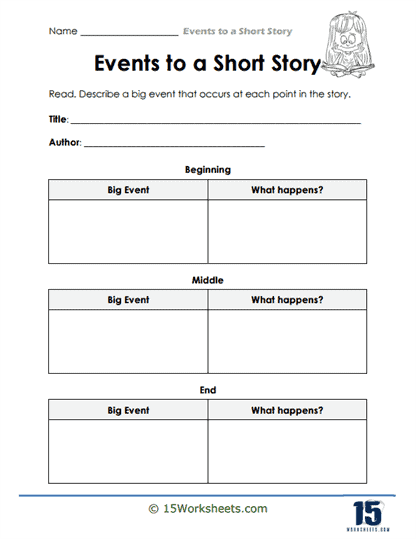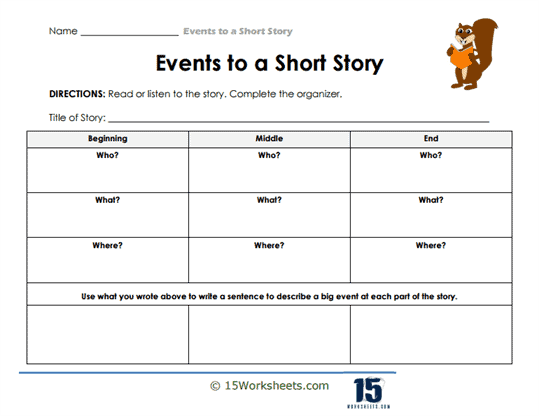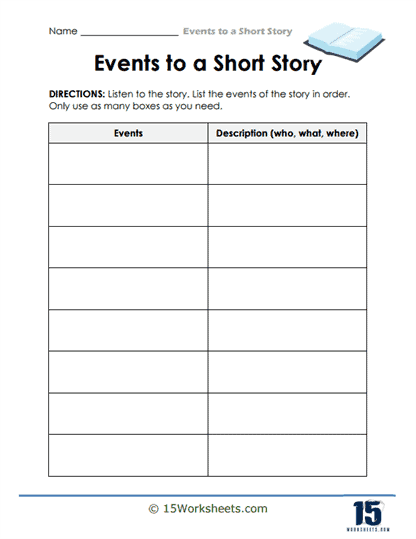Events to a Short Story Worksheets
About These 15 Worksheets
These worksheets were developed to enhance students’ reading comprehension, narrative understanding, and analytical skills. They focus on dissecting the events in a short story, allowing students to delve into the narrative structure and elements that compose a story. Utilizing these worksheets, students engage in various exercises that not only improve their reading skills but also foster critical thinking and creative expression.
They offer a comprehensive approach to understanding and analyzing short stories, catering to various aspects of reading and comprehension. These worksheets not only improve students’ reading ability but also contribute significantly to their overall literary acumen, critical thinking, and creative expression. Through a variety of engaging and thought-provoking exercises, these worksheets are instrumental in shaping competent and enthusiastic readers.
Understanding the Structure of a Short Story
Before delving into the types of exercises, it’s crucial to understand the structure of a short story. A typical short story follows a narrative arc that includes an exposition (introduction of characters and setting), rising action (events leading to the climax), climax (turning point), falling action (events post-climax), and resolution (conclusion of the story). Understanding this structure is pivotal in analyzing any story.
Types of Exercises
Event Sequencing – These exercises require students to arrange events in the order they occur in the story. This practice enhances their ability to understand narrative flow and the cause-and-effect relationship between different events. Students match characters to specific events, improving their understanding of character actions and motivations, and how these drive the story forward.
Identifying Key Events – Exercises that focus on pinpointing key events in the story help students distinguish between major and minor plot points, enhancing their ability to summarize and analyze narratives. Worksheets may include sections where students predict future events based on current story progression. This exercise enhances inferential skills and encourages engagement with the text.
Cause and Effect Relationships – Identifying the cause and effect in different scenarios within the story helps students understand the logical flow and consequences of events and character decisions. Exercises that involve comparing and contrasting events within the story or with another story help in developing analytical skills and a deeper understanding of thematic elements.
Creative Extension Tasks – Students might be asked to write alternate endings or additional scenes, encouraging creative thinking and deeper engagement with the text. Creating storyboards or drawing scenes requires students to interpret events visually, enhancing their comprehension and retention. Worksheets often include questions that provoke discussion and personal reflection about the events and their impact, aiding in developing critical thinking and personal connection to the text.
Character Reaction Analysis – Students analyze how characters react to certain events, which helps in understanding character development and the emotional landscape of the story. Building a timeline of events from the story aids in understanding the chronological sequence and how time affects the narrative. Recognizing themes based on events in the story enhances students’ ability to conduct thematic analysis, a key skill in literary comprehension.
The Benefits of These Worksheets
These worksheets offers a multitude of benefits. The first of these advantages is enhanced comprehension. By breaking down the story into its constituent events, students are able to gain a deeper understanding of the narrative, ultimately improving their overall reading comprehension. This process allows them to explore the storyline on a granular level, deciphering the connections between various events and characters.
This approach contributes to improved analytical skills. As students delve into the events, characters, and their interrelations, their ability to analyze and dissect complex narratives is sharpened. This analytical prowess equips them with the tools to deconstruct the story’s components, unraveling its intricacies and uncovering hidden layers of meaning.
Practicing with these worksheets aids in better memory retention. The act of sequencing and recounting events necessitates the recall of details from the story, which, in turn, enhances memory retention. By actively engaging with the material, students reinforce their memory of key plot points and character developments.
In addition to memory retention, these worksheets foster the development of inferential thinking. Predictive and cause-and-effect exercises encourage students to infer and draw conclusions, a crucial skill in reading comprehension. This ability to connect the dots between events and characters not only aids in understanding the story but also encourages critical thinking.
Increased engagement is another notable benefit. Creative and reflective exercises included in the worksheets enhance students’ engagement with the text. By encouraging them to explore the story’s events from different perspectives, these exercises make reading a more enjoyable and immersive experience. Students become active participants in the narrative, making their reading experience more enriching.
Working with these can contribute to fostering critical thinking. Through discussions and reflections on events, students develop critical thinking skills. They learn to question and analyze narratives beyond their surface level, encouraging a deeper and more nuanced understanding of the story.
The worksheets also enhance writing skills. Creative extension tasks and writing exercises related to the events of the story provide students with opportunities to practice and improve their writing abilities. These tasks not only help develop their writing skills but also deepen their understanding of the narrative structure.
One of the most substantial aspects of these worksheets is how they can help improve your understanding narrative structure. Through these exercises, students learn about the architecture of a short story, enabling them to recognize and appreciate the craftsmanship behind storytelling. This comprehension of narrative structure enriches their reading experience and allows them to become more discerning readers.















